Grain Size Distribution of Bedload Transport in a Glaciated Catchment (Baranowski Glacier, King George Island, Western Antarctica)
Abstract
:1. Introduction
2. Materials and Methods
2.1. Study Site
2.2. Bedload Transport Measurements
2.3. Sieve Method and GSD Analysis
2.4. Bedload Transport Rate
2.5. Statistical Analysis
3. Results
3.1. Statistical Analysis: Water Discharge, Flow Velocity, and Bedload Transport
3.2. Sieving Procedure Comparison (Wet and Dry)
3.3. GSD Parameters and Variation of Characteristic Diameters (D) of the Bedload Transport Rate
3.4. Selective Transport and Bedload Transport versus Water Discharge and Water Velocity
4. Discussion
5. Conclusions
Acknowledgments
Author Contributions
Conflicts of Interest
References
- Wu, W.; Wang, S.S.; Jia, Y. Nonuniform sediment transport in alluvial rivers. J. Hydraul. Res. 2000, 38, 427–434. [Google Scholar] [CrossRef]
- Wilcock, P.R.; Crowe, J.C. Surface-based transport model for mixed-size sediment. J. Hydraul. Eng. 2003, 129, 120–128. [Google Scholar] [CrossRef]
- Lukerchenko, N.; Chara, Z.; Vlasak, P. 2D Numerical model of particle–bed collision in fluid-particle flows over bed. J. Hydraul. Res. 2006, 44, 70–78. [Google Scholar] [CrossRef]
- Bialik, R.J. Numerical study of saltation of non-uniform grains. J. Hydraul. Res. 2011, 49, 697–701. [Google Scholar] [CrossRef]
- Andrews, E.D.; Erman, D.C. Persistence in the size distribution of surficial bed material during an extreme snowmelt flood. Water Resour. Res. 1986, 22, 191–197. [Google Scholar] [CrossRef]
- Powell, D.M.; Reid, I.; Laronne, J.B. Evolution of bed load grain size distribution with increasing flow strength and the effect of flow duration on the caliber of bed load sediment yield in ephemeral gravel bed rivers. Water Resour. Res. 2001, 37, 1463–1474. [Google Scholar] [CrossRef]
- Török, G.T.; Baranya, S.; Rüther, N. 3D CFD modeling of local scouring, bed armoring and sediment deposition. Water 2017, 9, 56. [Google Scholar]
- Syvitski, J.P.; Peckham, S.D.; Hilberman, R.; Mulder, T. Predicting the terrestrial flux of sediment to the global ocean: A planetary perspective. Sediment. Geol. 2003, 162, 5–24. [Google Scholar] [CrossRef]
- Ashworth, P.J.; Ferguson, R.I. Interrelationships of channel processes, changes and sediments in a proglacial braided river. Geogr. Ann. Ser. Phys. Geogr. 1986, 68, 361–371. [Google Scholar] [CrossRef]
- Carson, M.A.; Griffiths, G.A. Bedload transport in gravel channels. J. Hydrol. N. Z. 1987, 26, 1–151. [Google Scholar]
- Ferguson, R.I.; Ashmore, P.E.; Ashworth, P.J.; Paola, C.; Prestegaard, K.L. Measurements in a braided river chute and lobe: 1. Flow pattern, sediment transport, and channel change. Water Resour. Res. 1992, 28, 1877–1886. [Google Scholar] [CrossRef]
- Goff, J.R.; Ashmore, P. Gravel transport and morphological change in braided Sunwapta River, Alberta, Canada. Earth Surf. Process. Landf. 1994, 19, 195–212. [Google Scholar] [CrossRef]
- Hassan, M.A.; Church, M.; Lisle, T.E.; Brardinoni, F.; Benda, L.; Grant, G.E. Sediment transport and channel morphology of small, forested streams. JAWRA J. Am. Water Resour. Assoc. 2005, 41, 853–876. [Google Scholar] [CrossRef]
- Kociuba, W.; Janicki, G.; Siwek, K.; Gluza, A. Bedload transport as an indicator of contemporary transformations of arctic fluvial systems. In Monitoring Simulation Prevention and Remediation of Dense and Debris Flows IV; WIT Press: Boston, MA, USA, 2012; pp. 125–135. [Google Scholar]
- Folk, R.L.; Ward, W.C. Brazos River bar: A study in the significance of grain size parameters. J. Sediment. Petrol. 1957, 27, 3–26. [Google Scholar] [CrossRef]
- Visher, G.S. Grain size distributions and depositional processes. J. Sediment. Res. 1969, 39, 1074–1106. [Google Scholar]
- Bagnold, R.A. Bed load transport by natural rivers. Water Resour. Res. 1977, 13, 303–312. [Google Scholar] [CrossRef]
- Friedman, G.M. Differences in size distributions of populations of particles among sands of various origins: addendum to IAS Presidential Address. Sedimentology 1979, 26, 859–862. [Google Scholar] [CrossRef]
- Proffitt, G.T.; Sutherland, A.J. Transport of non-uniform sediments. J. Hydraul. Res. 1983, 21, 33–43. [Google Scholar] [CrossRef]
- Wilcock, P.R.; McArdell, B.W. Surface-based fractional transport rates: Mobilization thresholds and partial transport of a sand-gravel sediment. Water Resour. Res. 1993, 29, 1297–1312. [Google Scholar] [CrossRef]
- Wilcock, P.R.; McArdell, B.W. Partial transport of a sand/gravel sediment. Water Resour. Res. 1997, 33, 235–245. [Google Scholar] [CrossRef]
- Reid, I.; Frostick, L.E.; Layman, J.T. The incidence and nature of bedload transport during flood flows in coarse-grained alluvial channels. Earth Surf. Process. Landf. 1985, 10, 33–44. [Google Scholar] [CrossRef]
- Lisle, T.E. Particle size variations between bed load and bed material in natural gravel bed channels. Water Resour. Res. 1995, 31, 1107–1118. [Google Scholar] [CrossRef]
- Bui, E.N.; Mazzullo, J.M.; Wilding, L.P. Using quartz grain size and shape analysis to distinguish between aeolian and fluvial deposits in the Dallol Bosso of Niger (West Africa). Earth Surf. Process. Landf. 1989, 14, 157–166. [Google Scholar] [CrossRef]
- Ashworth, P.J.; Ferguson, R.I.; Ashmore, P.E.; Paola, C.; Powell, D.M.; Prestegaards, K.L. Measurements in a braided river chute and lobe: 2. Sorting of bed load during entrainment, transport, and deposition. Water Resour. Res. 1992, 28, 1887–1896. [Google Scholar] [CrossRef]
- Schneider, J.M.; Turowski, J.M.; Rickenmann, D.; Hegglin, R.; Arrigo, S.; Mao, L.; Kirchner, J.W. Scaling relationships between bed load volumes, transport distances, and stream power in steep mountain channels. J. Geophys. Res. Earth Surf. 2014, 119, 533–549. [Google Scholar] [CrossRef]
- McLaren, P.; Bowles, D. The effects of sediment transport on grain-size distributions. J. Sediment. Petrol. 1985, 55, 457–470. [Google Scholar]
- Bialik, R.J.; Nikora, V.I.; Rowiński, P.M. 3D Lagrangian modelling of saltating particles diffusion in turbulent water flow. Acta Geophys. 2012, 60, 1639–1660. [Google Scholar] [CrossRef]
- Bialik, R.J.; Nikora, V.I.; Karpiński, M.; Rowiński, P.M. Diffusion of bedload particles in open-channel flows: Distribution of travel times and second-order statistics of particle trajectories. Environ. Fluid Mech. 2015, 15, 1281–1292. [Google Scholar] [CrossRef] [Green Version]
- Bakke, P.D.; Sklar, L.S.; Dawdy, D.R.; Wang, W.C. The Design of a Site-Calibrated Parker–Klingeman Gravel Transport Model. Water 2017, 9, 441. [Google Scholar] [CrossRef]
- Kociuba, W.; Janicki, G. Changeability of movable bed-surface particles in natural, gravel-bed channels and its relation to bedload grain size distribution (scott river, svalbard). Geogr. Ann. Ser. Phys. Geogr. 2015, 97, 507–521. [Google Scholar] [CrossRef]
- Ghoshal, K.; Mazumder, B.S.; Purkait, B. Grain-size distributions of bed load: Inferences from flume experiments using heterogeneous sediment beds. Sediment. Geol. 2010, 223, 1–14. [Google Scholar] [CrossRef]
- Parker, G.; Klingeman, P.C. On Why Gravel Bed Streams Are Paved. Water Resour. Res. 1982, 18, 1409–1423. [Google Scholar] [CrossRef]
- Buffington, J.M.; Montgomery, D.R. A systematic analysis of eight decades of incipient motion studies, with special reference to gravel-bedded rivers. Water Resour. Res. 1997, 33, 1993–2029. [Google Scholar] [CrossRef]
- Church, M.; Hassan, M.A. Mobility of bed material in Harris Creek. Water Resour. Res. 2002, 38. [Google Scholar] [CrossRef]
- Batalla, R.J.; Vericat, D.; Gibbins, C.N.; Garcia, C. Incipient bed-material motion in a gravel-bed river: Field observations and measurements. U. S. Geol. Surv. Sci. Investig. Rep. 2010, 5091, 15. [Google Scholar]
- Turowski, J.M.; Badoux, A.; Rickenmann, D. Start and end of bedload transport in gravel-bed streams. Geophys. Res. Lett. 2011, 38. [Google Scholar] [CrossRef]
- Johnson, J.P. Gravel threshold of motion: A state function of sediment transport disequilibrium? Earth Surf. Dyn. 2016, 4, 685. [Google Scholar] [CrossRef]
- Ferguson, R.I.; Prestegaard, K.L.; Ashworth, P.J. Influence of sand on hydraulics and gravel transport in a braided gravel bed river. Water Resour. Res. 1989, 25, 635–643. [Google Scholar] [CrossRef]
- Komar, P.D.; Li, Z. Pivoting analyses of the selective entrainment of sediments by shape and size with application to gravel threshold. Sedimentology 1986, 33, 425–436. [Google Scholar] [CrossRef]
- Naden, P. An erosion criterion for gravel-bed rivers. Earth Surf. Process. Landf. 1987, 12, 83–93. [Google Scholar] [CrossRef]
- Wiberg, P.L.; Smith, J.D. Calculations of the critical shear stress for motion of uniform and heterogeneous sediments. Water Resour. Res. 1987, 23, 1471–1480. [Google Scholar] [CrossRef]
- Duan, J.G.; Scott, S. Selective bed-load transport in Las Vegas Wash, a gravel-bed stream. J. Hydrol. 2007, 342, 320–330. [Google Scholar] [CrossRef]
- Ashworth, P.J.; Ferguson, R.I. Size-selective entrainment of bed load in gravel bed streams. Water Resour. Res. 1989, 25, 627–634. [Google Scholar] [CrossRef]
- Ashworth, P.J.; Ferguson, R.I.; Powell, D.M. Bedload transport and sorting in braided channels. In Dynamics of Gravel-Bed Rivers; Bili, P., Hey, R.D., Thorne, C.R., Tacconi, P., Eds.; John Wiley: Hoboken, NJ, USA, 1992; pp. 497–513. [Google Scholar]
- Sziło, J.; Bialik, R.J. Bedload transport in two creeks at the ice-free area of the Baranowski Glacier, King George Island, West Antarctica. Pol. Polar Res. 2017, 38, 21–39. [Google Scholar] [CrossRef]
- Doran, P.T.; Priscu, J.C.; Lyons, W.B.; Walsh, J.E.; Fountain, A.G.; McKnight, D.M.; Moorhead, D.L.; Virginia, R.A.; Wall, D.H.; Clow, G.D. Antarctic climate cooling and terrestrial ecosystem response. Nature 2002, 415, 517–520. [Google Scholar] [CrossRef] [PubMed]
- Ferron, F.A.; Simões, J.C.; Aquino, F.E.; Setzer, A.W. Air temperature time series for King George Island, Antarctica. Pesqui. Antártica Bras. 2004, 4, 155–169. [Google Scholar]
- Kejna, M. Air temperature on King George Island, South Shetland Islands, Antarctica. Pol. Polar Res. 1999, 20, 183–201. [Google Scholar]
- Kejna, M. Trends of air temperature of the Antarctic during the period 1958–2000. Pol. Polar Res. 2003, 24, 99–126. [Google Scholar]
- Kejna, M.; Araźny, A.; Sobota, I. Climatic change on King George Island in the years 1948–2011. Pol. Polar Res. 2013, 34, 213–235. [Google Scholar] [CrossRef]
- Van den Broeke, M.R. On the interpretation of Antarctic temperature trends. J. Clim. 2000, 13, 3885–3889. [Google Scholar] [CrossRef]
- Pętlicki, M.; Sziło, J.; MacDonell, S.; Vivero, S.; Bialik, R. Recent Deceleration of the Ice Elevation Change of Ecology Glacier (King George Island, Antarctica). Remote Sens. 2017, 9, 520. [Google Scholar] [CrossRef]
- Arctic and Antarctic Research Institute, St. Petersburg. Available online: http://www.aari.aq/data/data.php?lang=1&station=0 (accessed on 11 January 2018).
- Kociuba, W.; Janicki, G. Continuous measurements of bedload transport rates in a small glacial river catchment in the summer season (Spitsbergen). Geomorphology 2014, 212, 58–71. [Google Scholar] [CrossRef]
- Kociuba, W. Determination of the bedload transport rate in a small proglacial High Arctic stream using direct, semi-continuous measurement. Geomorphology 2017, 287, 101–115. [Google Scholar] [CrossRef]
- Blott, S.J.; Pye, K. GRADISTAT: A grain size distribution and statistics package for the analysis of unconsolidated sediments. Earth Surf. Process. Landf. 2001, 26, 1237–1248. [Google Scholar] [CrossRef]
- Bialik, R.J.; Karpiński, M.; Rajwa, A. Discharge measurements in lowland rivers: Field comparison between an electromagnetic open channel flow meter (EOCFM) and an acoustic Doppler current profiler (ADCP). In Achievements, History and Challenges in Geophysics; Springer: New York, NY, USA, 2014; pp. 213–222. [Google Scholar]
- Feng, C.; Wang, H.; Lu, N.; Tu, X.M. Log transformation: Application and interpretation in biomedical research. Stat. Med. 2013, 32, 230–239. [Google Scholar] [CrossRef] [PubMed]
- Robertson, J.; Thomas, C.J.; Caddy, B.; Lewis, A.J. Particle size analysis of soils—A comparison of dry and wet sieving techniques. Forensic Sci. Int. 1984, 24, 209–217. [Google Scholar] [CrossRef]
- Kemper, W.D.; Rosenau, R.C. Aggregate stability and size distribution. In Methods of Soil Analysis. Part 1. Physical and Mineralogical Methods—Agronomy Monography; Soil Science Society of America: Madison, WI, USA, 1986; Volume 1, pp. 425–442. [Google Scholar]
- Kociuba, W. Bedload transport in a High Arctic gravel-bed river (Scott River, Svalbard SW). In New Perspectives in Polar Research; Institute of Geography and Regional Development, University of Wroclaw: Wrocław, Poland, 2014; pp. 231–246. [Google Scholar]
- Zagórski, P.; Siwek, K.; Gluza, A.; Bartoszewski, S.A. Changes in the extent and geometry of the Scott Glacier, Spitsbergen. Pol. Polar Res. 2008, 2, 163–185. [Google Scholar]
- Kondolf, G.M.; Wolman, M.G. The sizes of salmonid spawning gravels. Water Resour. Res. 1993, 29, 2275–2285. [Google Scholar] [CrossRef]
- Komar, P.D.; Carling, P.A. Grain sorting in gravel-bed streams and the choice of particle sizes for flow-competence evaluations. Sedimentology 1991, 38, 489–502. [Google Scholar] [CrossRef]
- Wathen, S.J.; Ferguson, R.I.; Hoey, T.B.; Werritty, A. Unequal mobility of gravel and sand in weakly bimodal river sediments. Water Resour. Res. 1995, 31, 2087–2096. [Google Scholar] [CrossRef]
- Church, M.; Hassan, M.A. Upland gravel-bed rivers with low sediment transport. Dev. Earth Surf. Process. 2005, 7, 141–168. [Google Scholar] [CrossRef]
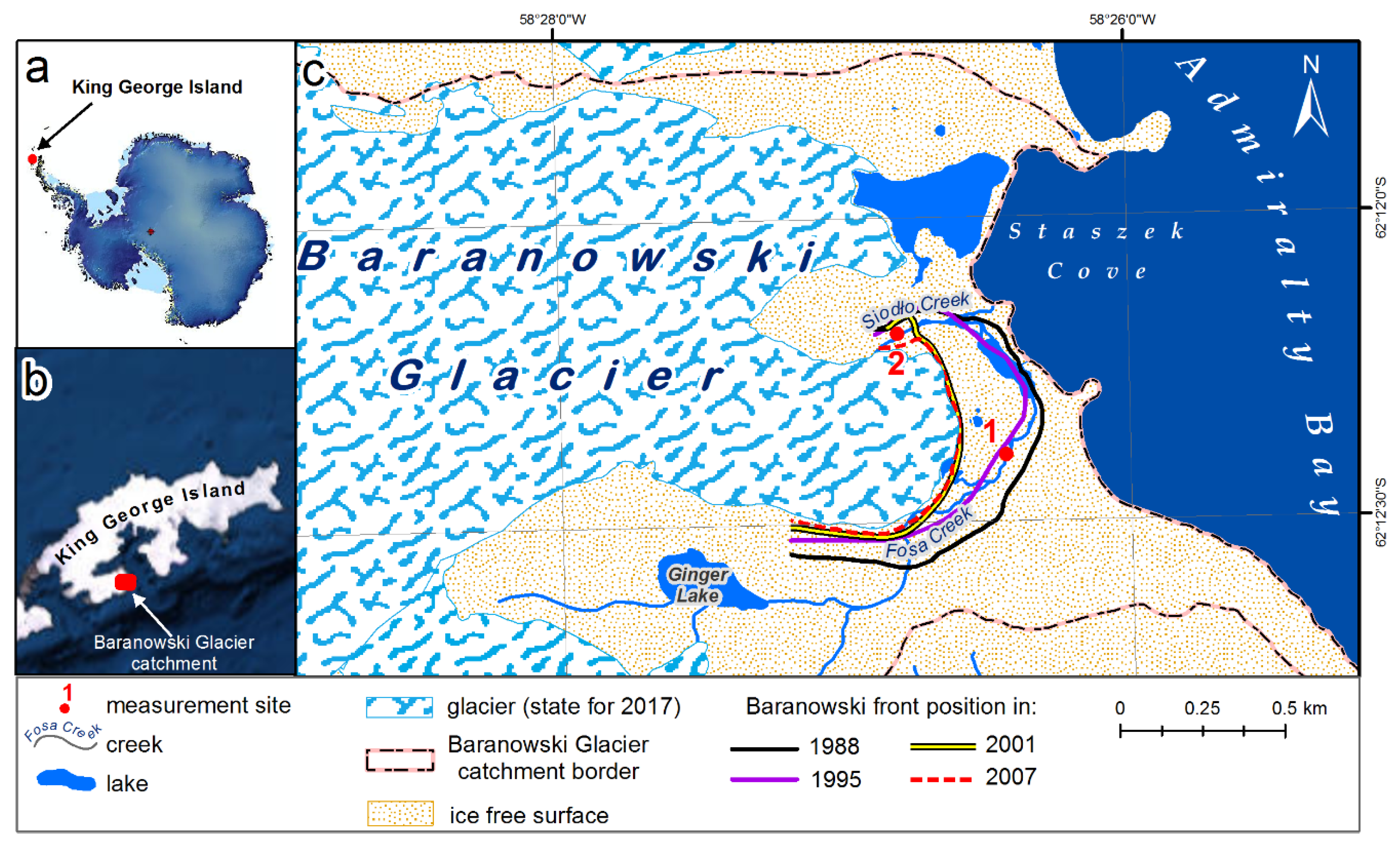
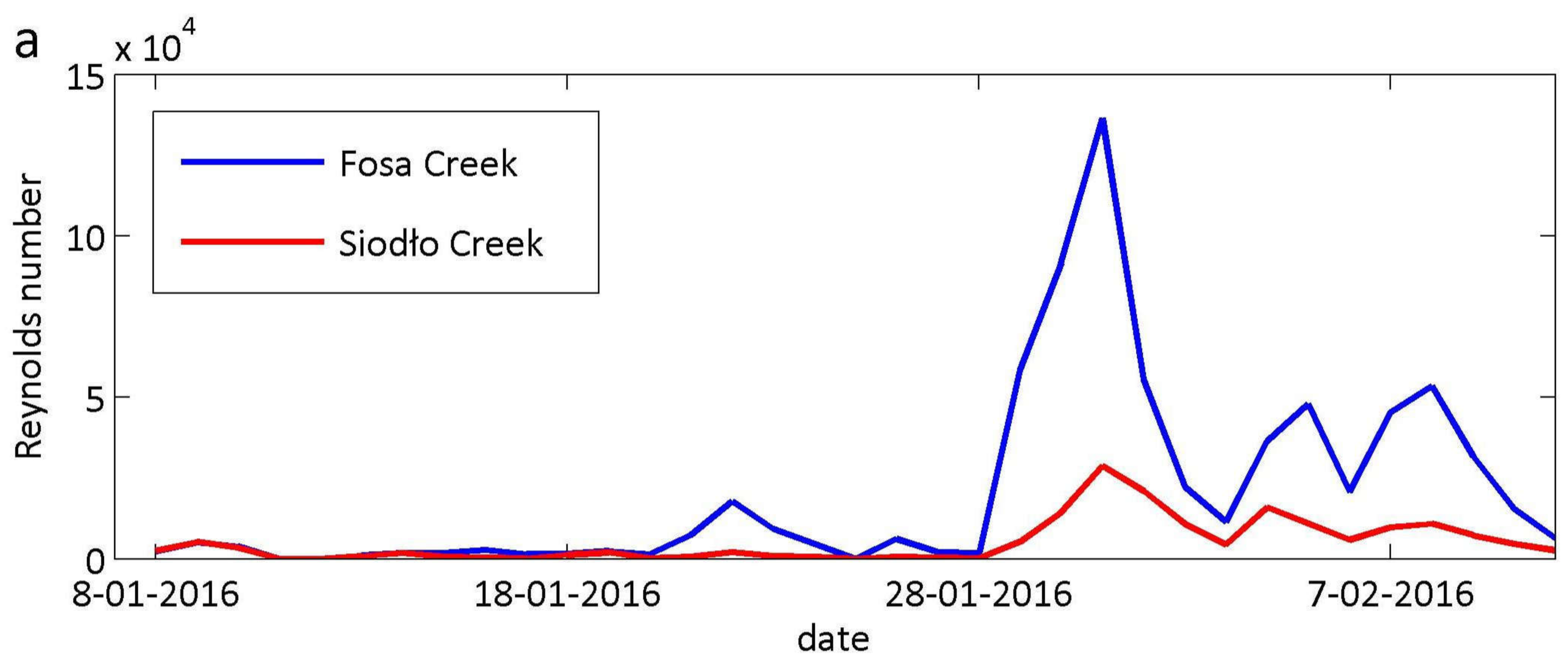
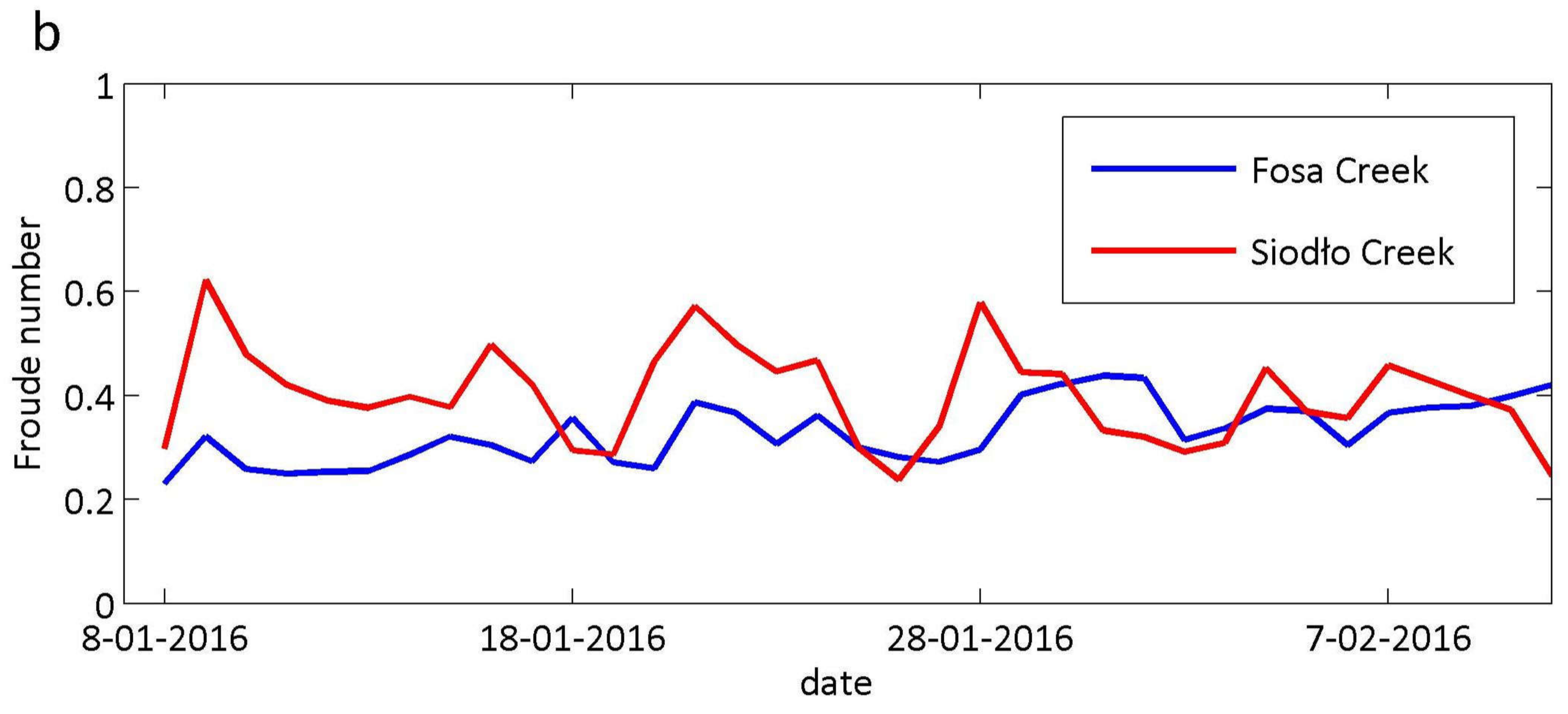


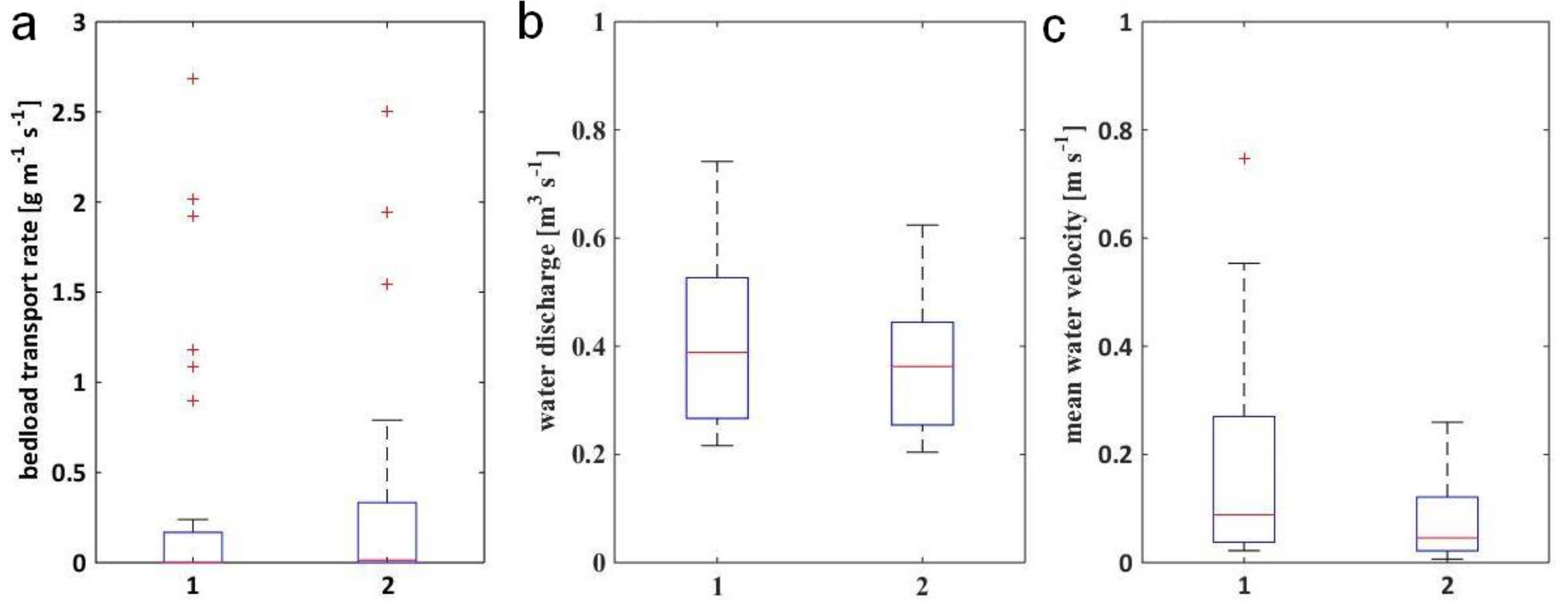

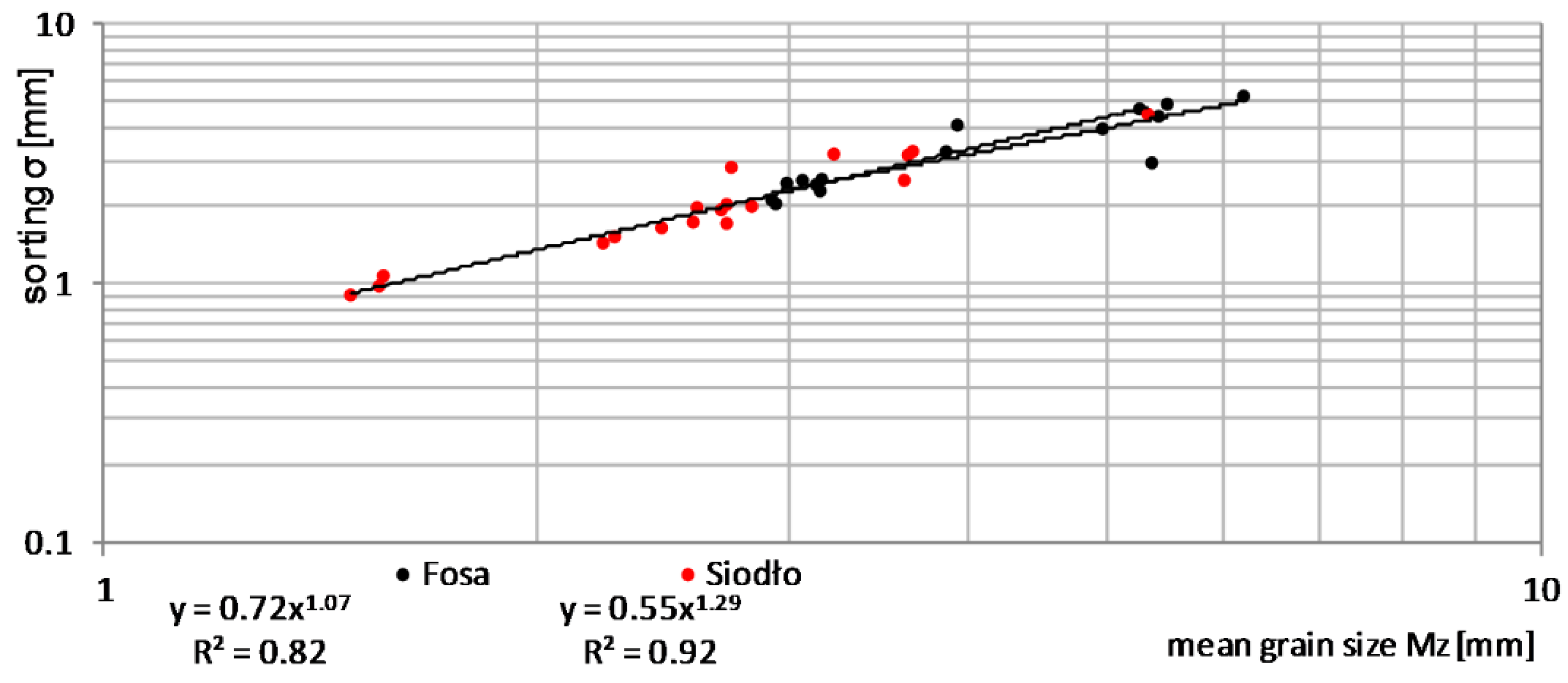


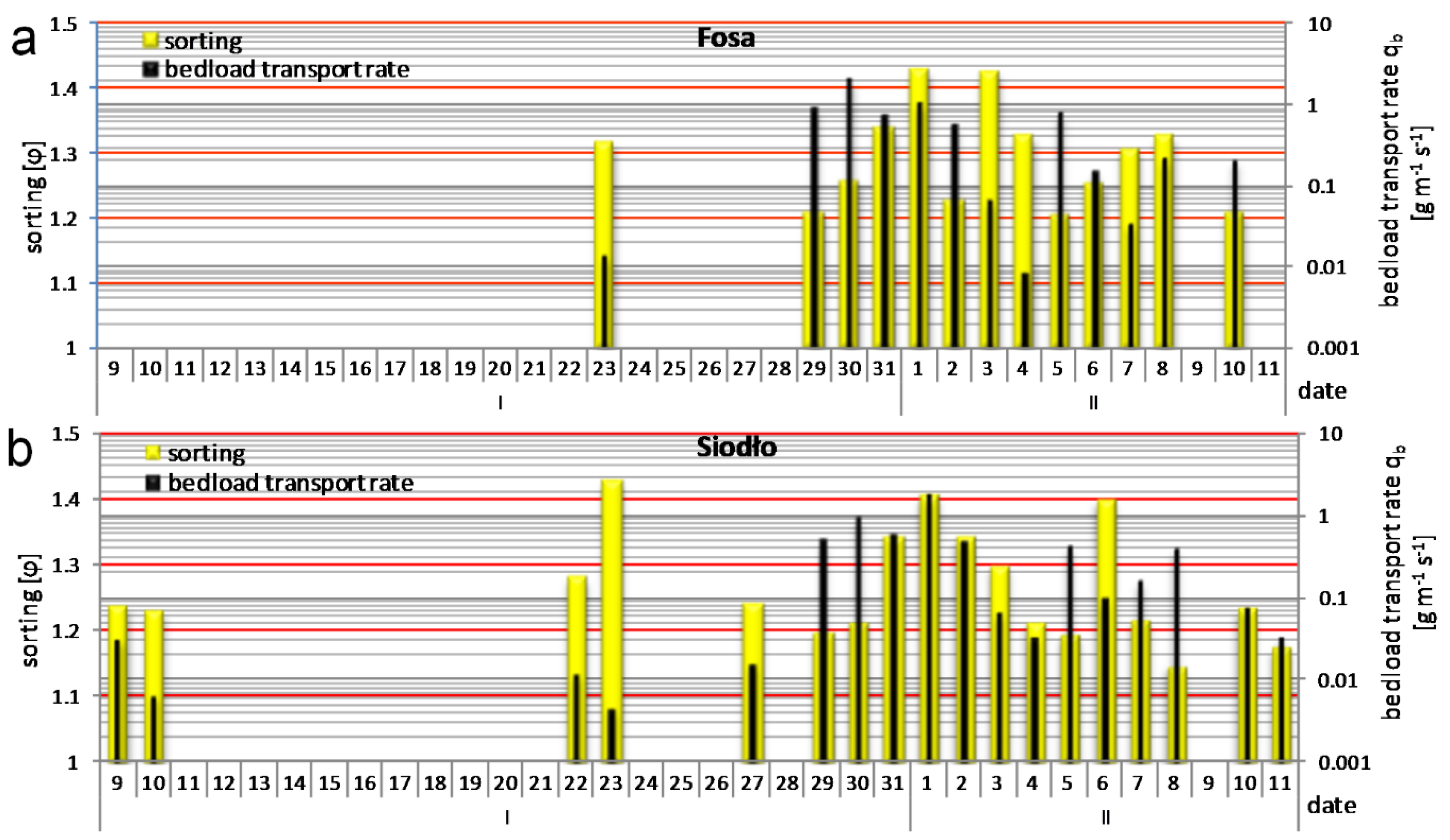
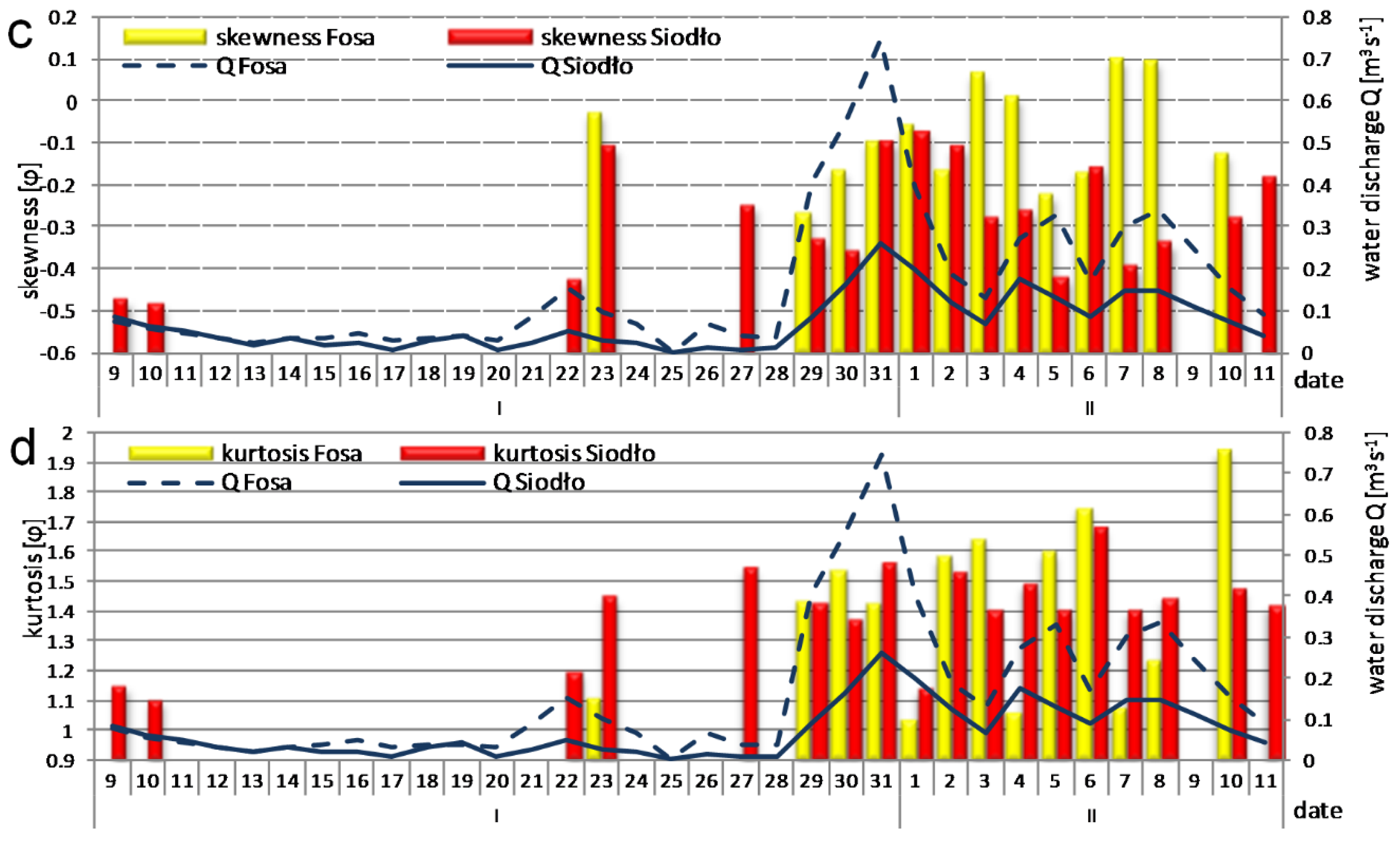
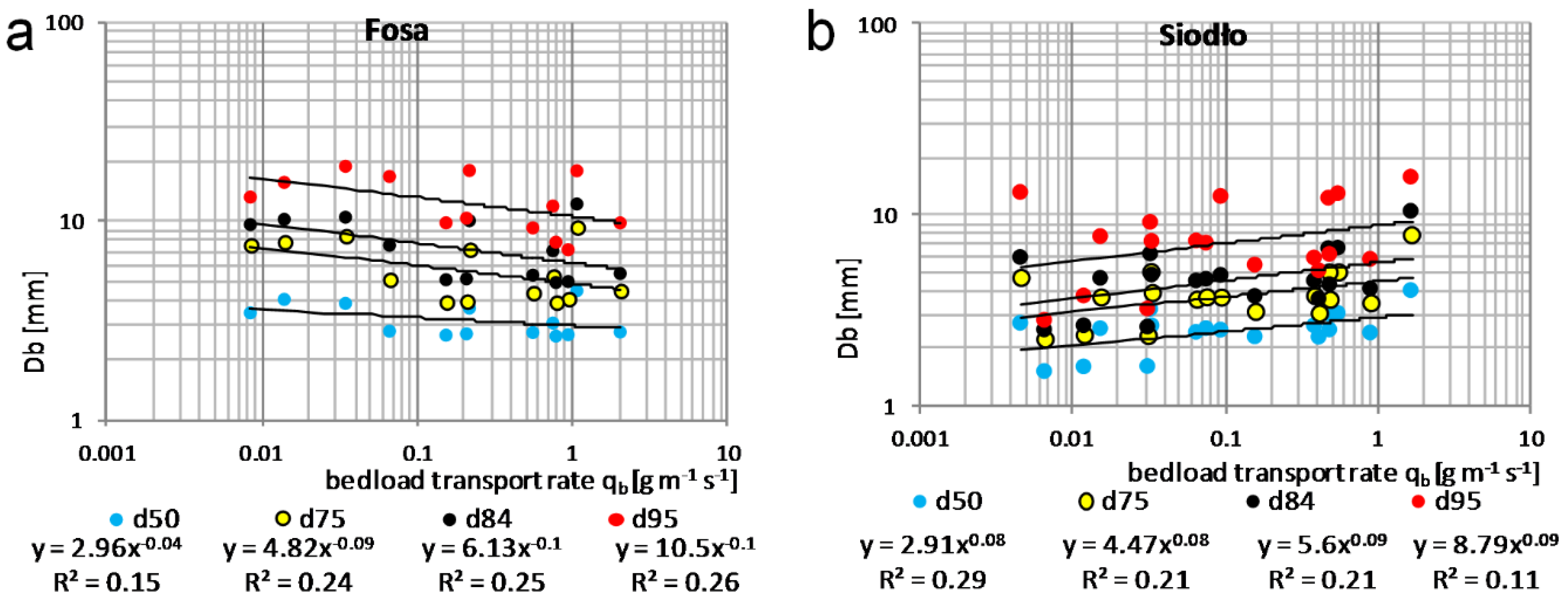

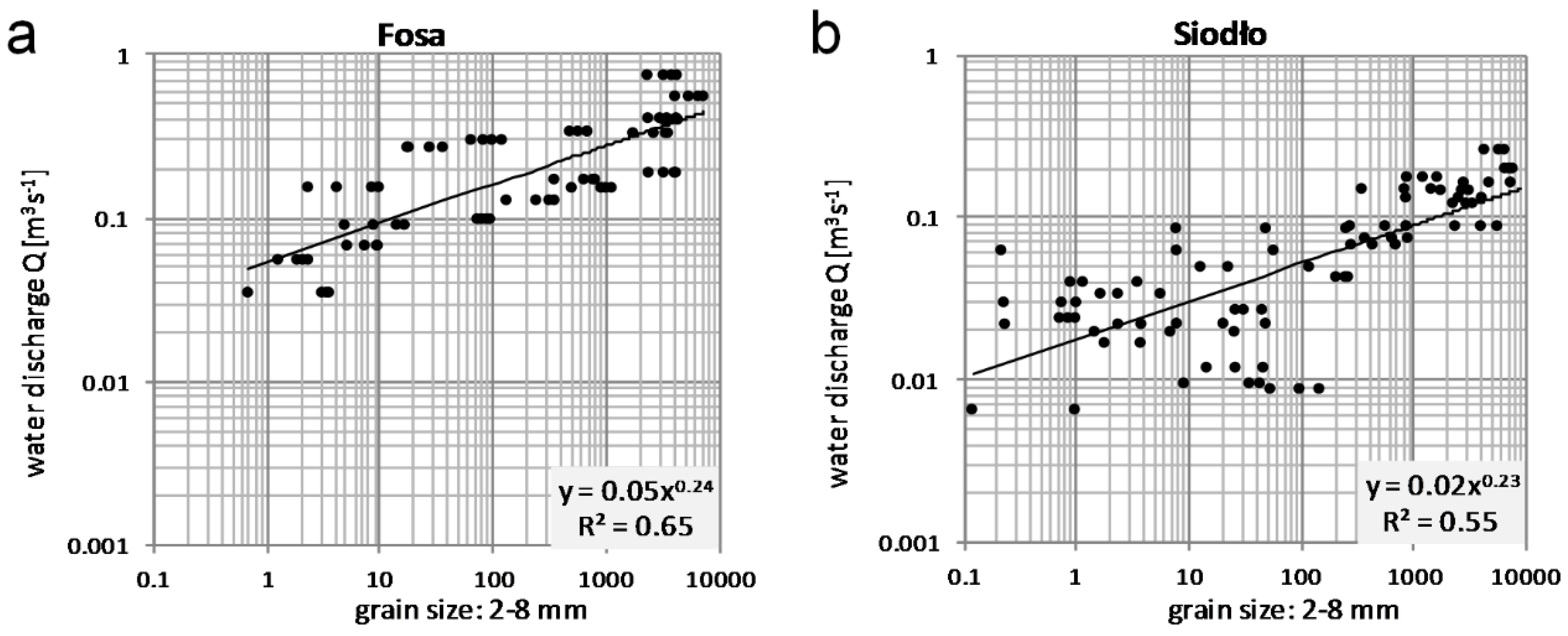

| Parameter | Total Length (L) [km] | Average Bankfull Width (w) [m] | Average Bankfull Depth (d) [m] | Longitudinal Water Surface Slope (S) [mm−1] | Maximum Discharge (Qmax) [m3 s−1] 1 | Maximum Velocity (Vmax) [ms−1] 2 |
|---|---|---|---|---|---|---|
| Fosa Creek | 1.40 | 2.82 | 0.14 | 0.07 | 0.75 | 0.91 |
| Siodło Creek | 0.42 | 2.15 | 0.09 | 0.08 | 0.26 | 1.25 |
© 2018 by the authors. Licensee MDPI, Basel, Switzerland. This article is an open access article distributed under the terms and conditions of the Creative Commons Attribution (CC BY) license (http://creativecommons.org/licenses/by/4.0/).
Share and Cite
Sziło, J.; Bialik, R.J. Grain Size Distribution of Bedload Transport in a Glaciated Catchment (Baranowski Glacier, King George Island, Western Antarctica). Water 2018, 10, 360. https://doi.org/10.3390/w10040360
Sziło J, Bialik RJ. Grain Size Distribution of Bedload Transport in a Glaciated Catchment (Baranowski Glacier, King George Island, Western Antarctica). Water. 2018; 10(4):360. https://doi.org/10.3390/w10040360
Chicago/Turabian StyleSziło, Joanna, and Robert Józef Bialik. 2018. "Grain Size Distribution of Bedload Transport in a Glaciated Catchment (Baranowski Glacier, King George Island, Western Antarctica)" Water 10, no. 4: 360. https://doi.org/10.3390/w10040360





